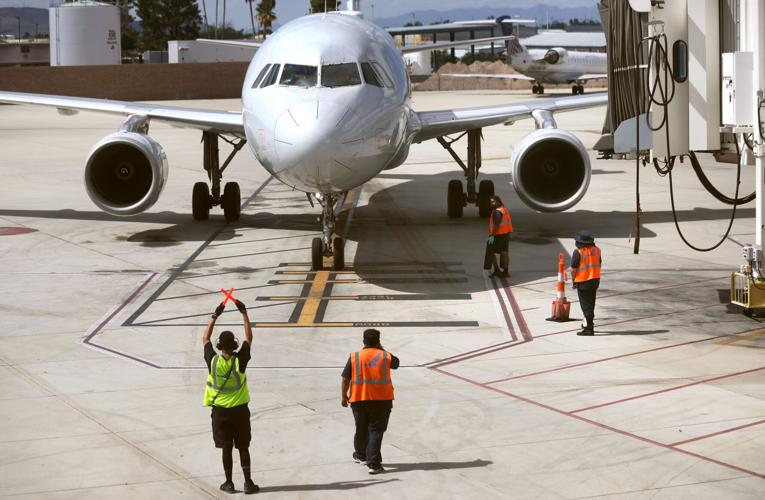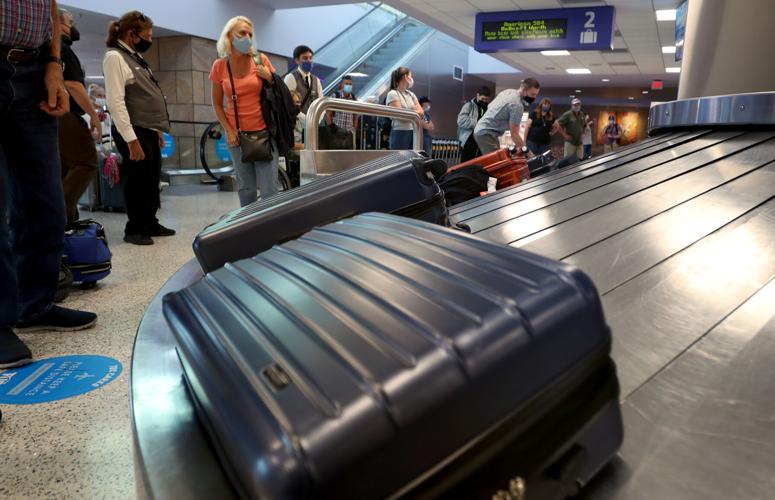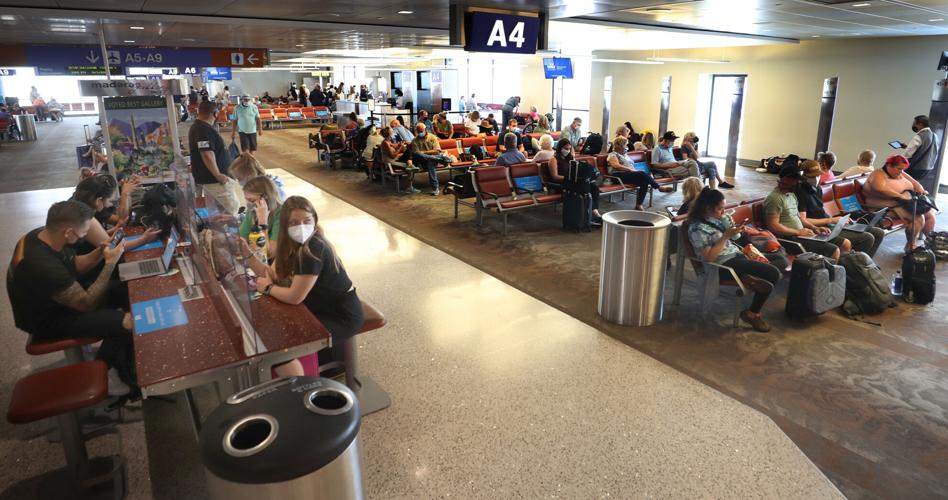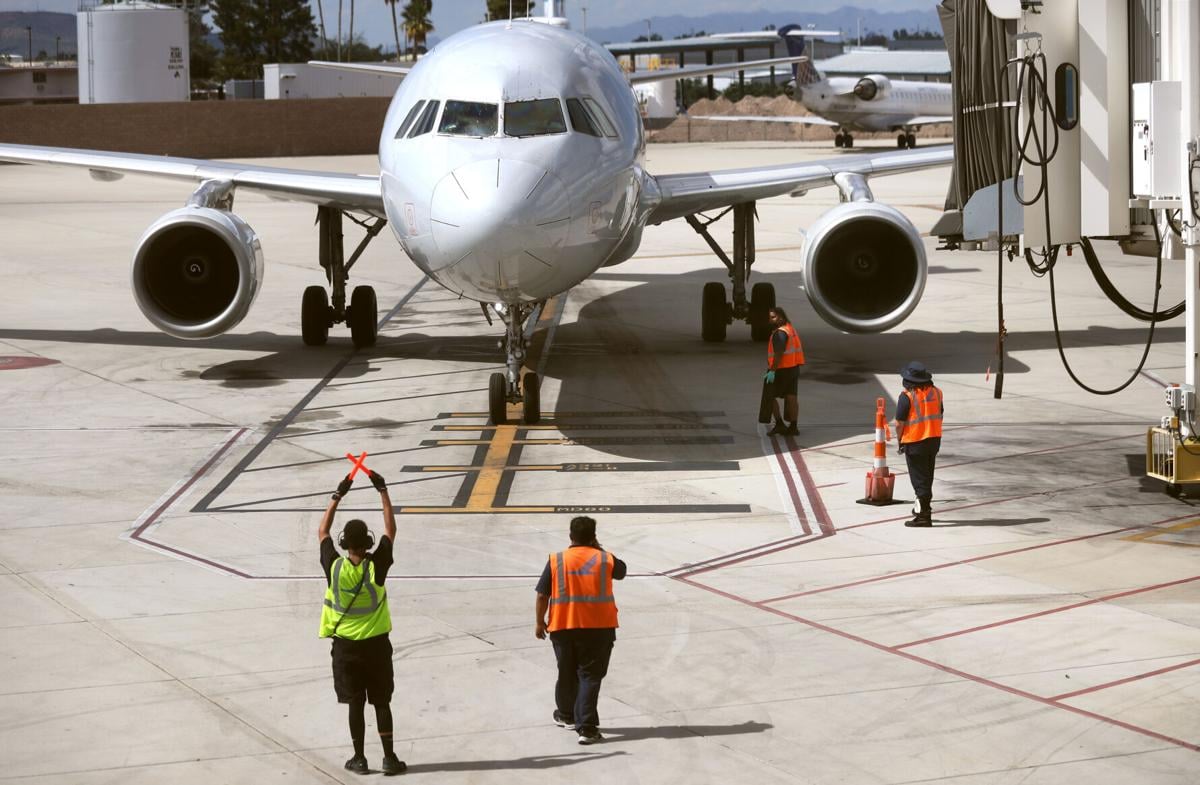Tucson International Airport didn’t recover to its pre-pandemic passenger traffic levels in 2021, but some airlines gave the airport a vote of confidence by restoring many routes and adding seat capacity.
And after getting an infusion of federal airport COVID-19 relief funding, TIA was awarded federal infrastructure grants that are expected to speed up construction on the airport’s $350 million airfield safety improvement project.
By the end of 2021, TIA had recovered 85% of its passenger volume compared with pre-COVID 2019, the Tucson Airport Authority said in its recently released annual review.
TIA served about 2.7 million passengers, including departures and arrivals, in 2021, up nearly 59% from 2020 but down 29% from nearly 3.8 million passengers in 2019.
“In 2020, after the pandemic hit, it was a little bit sketchy there for those first few months, then it’s been kind of a slow climb back to where we are today,” said Danette Bewley, president and CEO of the Tucson Airport Authority.
Airport officials were hoping to get about 90% of passenger traffic at TIA back this year before the omicron variant of COVID-19 caused a surge in cases and crimped air travel, Bewley said.
“That threw a big monkey wrench into the works, and we’ve had some setbacks already in this fiscal year due to omicron,” she said, citing moves by airlines to change or cancel flights largely due to staffing challenges.
“It’s hard to predict where we’re going to go, whether we’ll reach that 90% expectation,” Bewley said. “We’re thrilled with the service we do have, and when we compare it to some of our peer airports, we’re doing pretty well, and better than some. Our market is still strong, and people want to come to Tucson so that helps.”
But TIA’s recovery still depends on the pace of the airline industry’s rebound from the omicron surge and solving critical labor shortages, Bewley said, adding: “The airlines are hiring like crazy, but it’s just a really tough time.”
Taking steps forward, back
As of the end of 2021, nine airlines offered service to 19 nonstop destinations from TIA, after nonstop flights had dropped to 15 in 2020.
The airport added a new nonstop flight on Alaska Airlines to Everett, Washington, last year, which seems to be doing well, Bewley said.
Low-cost carrier Avelo Airlines launched a nonstop from Tucson to Hollywood Burbank Airport in December 2021 but dropped the flight in mid-January after a surge in COVID-19 cases from the omicron variant curtailed bookings.
Tucson also lost several routes when low-cost carrier Allegiant Air suspended its flights to Indianapolis; Provo, Utah; and Bellingham, Washington. Frontier Airlines dropped a nonstop to Denver last year but added a flight to Las Vegas.
But several major airlines restored service at TIA that was suspended during the height of the pandemic in 2020, including American and Southwest, which both reinstated flights to Los Angeles and Chicago.
TIA also gained additional service to Denver on American and Southwest, and Houston was added as a nonstop by United and Southwest.
A high level of demand during the latter half of 2021 should help encourage airlines to consider adding new routes at TIA, Bewley said.
Since April 2021, more than 80% of available seats at TIA were filled in every month except August, outpacing the U.S. recovery, the Airport Authority said.
“When you’re selling the airlines air service, you want to show them you have a strong market,” Bewley said.
Thanks to a strong air-travel recovery in the second half of the 2021 fiscal year ended Sept. 30, annual operating revenues came in about 5% above budget at $36.3 million, and expenses were 2.4% below budget, according to preliminary, unaudited financial results.
Bewley said airport officials were careful to adopt a conservative budget last year and used millions of dollars in federal COVID-19 relief funding mainly to pay staffing expenses as its revenues fell.

Tucson International Airport served about 2.7 million passengers, including departures and arrivals, in 2021, up nearly 59% from 2020 but down 29% from nearly 3.8 million passengers in 2019.
Marketing TIA
Despite the challenges posed by the pandemic, the Airport Authority moved ahead with a plan to attract new businesses to TIA and surrounding land owned by the airport in partnership with Sun Corridor Inc. to help drive local economic development.
In October, the authority launched its Commercial and Industrial Business Implementation Plan to help market land at TIA and at Ryan Airfield to prospective tenants.
The land available at TIA will be marketed as the “Sonoran Commerce Center” and is divided into four different areas based on the best use of the land. That plan has been shared with regional partners, national and international business-site selectors and is available on the Airport Authority website at tucne.ws/1jjze.
The authority also launched a new branding campaign, “Nonstop for Tucson,” to help restore confidence in TIA and to raise overall community awareness of the airport and its contribution to the Southern Arizona region.
Beginning in February 2021, the campaign advertised in local publications, digital platforms, social media, cable television, billboards, and was included in numerous community partnerships.
Project propelled
After years of study and design, the Airport Authority launched construction on the biggest construction project in TIA’s history last year when initial utilities work was completed and work on taxiways began in October, ahead of construction of a new full-length parallel runway.
The End-Around Taxiway project, which includes new taxiways to limit confusion that can cause hazardous runway incursions, is expected to be completed by January 2023.
The shorter, parallel runway to the main runway at TIA will be demolished and replaced with a new, full-length parallel runway to handle commercial airliners.
The new runway is expected to be finished by 2024, or 2025 depending on the pace of funding, said Mike Smejkal, vice president of planning and engineering for the Tucson Airport Authority.
After that, the current main runway will be closed for construction and commercial traffic shifted to the new runway so work can proceed on new taxiways between runways, which will take another year or so, Smejkal said.
Overall, he said, the airfield project has had only minor supply-chain issues because of COVID-19 but has faced some contractor labor shortages and rapidly rising costs.
But new federal funding will help cover higher costs and potentially speed up completion of the project, Smejkal said.

Since April 2021, more than 80% of available seats at TIA were filled in every month except August, outpacing the U.S. recovery, the Airport Authority said.
The airfield project is being funded mainly with grants from the Federal Aviation Administration’s Airport Improvement Program, which is funded by passenger surcharges, along with airport revenue and state grants.
Beyond that, TIA is expected to receive about $31 million in increments of just over $6 million annually over five years from the Infrastructure Investment and Jobs Act, which was signed into law last November.
The legislation authorized about $550 billion in new spending to upgrade infrastructure including broadband connectivity, roads and bridges and transportation including $25 billion to improve airports.
“That $31 million, we know we’re going to get it and it’s certainly above above what we have planned for,” Smejkal said. “We are also trying to unwind some other opportunities within that bill to get some competitive grants, to help accelerate it as well.”
Photos: Tucson International Airport history in photos

Curtiss biplanes from the U.S. Army Air Corps at Tucson Municipal Airport (now Davis-Monthan AFB) in 1933.

Tucson Municipal Airport (now Davis-Monthan AFB) in Feb. 1933.

Tucson Municipal Airport (now Davis-Monthan AFB) in Feb. 1933.

Runway lights at Tucson Municipal Airport, likely ca 1940s.

An old control tower at the Tucson Municipal Airport, now known as the Tucson International Airport. In the background are three hangars, one of which served as the old terminal building. Passengers waited in the shade of a long porch that extended from the terminal before walking to the airplane and climbing portable stairs to board the plane. The three hangars were the first buildings erected at the airport when it opened at its present location in the 1940s. They are still standing, and are located on the airport's west ramp.

Tucson Airport Authority "Rainbow" tower. Each layer painted a different color. Circa 1950.

Artist's rendering of what the control tower and operations building at Tucson International Airport will look like, January 14, 1957.

The new Tucson Municipal Airport control tower shortly after completion in 1958

Tucson International Airport iconic control tower in September, 1968.

Tucson International Airport tower in 1985.

A time exposure at Tucson International Airport in December, 1978. The lines are navigation lights from jets taking off.

The terminal building at the Tucson Municipal Airport, now known as the Tucson International Airport. Passengers waited in the shade of a long porch that extended from the terminal before walking to an airplane and climbing portable stairs to board the plane.

Passenger ramp under construction at Tucson Municipal Airport in 1948. Looking southeast from the original terminal building on the west side of the airport.

A pilot exits an F-84F Thunderstreak of the Arizona Air National Guard during the Ricks Memorial Trophy contest at Tucson International Airport on July 29, 1957. In the 1950s and 1960s the Air National Guard conducted the annual contest, a cross country timed air race designed to showcase the newly formed Air National Guard.

Spectators watch Arizona Air National Guard fighter jets compete in the Ricks Memorial Trophy contest at Tucson International Airport on July 29, 1957. In the 1950s and 1960s the Air National Guard conducted the annual contest, a cross country timed air race designed to showcase the newly formed Air National Guard.

Maj. Philip Colman streaks along the runway at 700 mph in an F-84F Thunderstreak as Arizona Air National Guard fighter jets compete in the Ricks Memorial Trophy contest at Tucson International Airport on July 29, 1957. In the 1950s and 1960s the Air National Guard conducted the annual contest, a cross country timed air race designed to showcase the newly formed Air National Guard.

Arizona Air National Guard fighter jets compete in the Ricks Memorial Trophy contest at Tucson International Airport on July 29, 1957. In the 1950s and 1960s the Air National Guard conducted the annual contest, a cross country timed air race designed to showcase the newly formed Air National Guard.

Tucson Municipal Airport air traffic controllers "scramble" Air National Guard fighter interceptor jets in March, 1959.

An Arizona Air National Guard F-100 fighter takes off from Tucson International Airport in June, 1965.

A new restaurant, left, opened with the RONtel Motel for "transient aviation" at the base of the tower at Tucson International Airport in 1960. Both buildings were designed by Tucson architect Arthur Brown.

The U.S. Weather Bureau office in 1959, near the flight line at Tucson Municipal Airport provided weather information for pilots and weather reports for Tucson residents.

Hangers on the west side of Tucson International Airport in 1970. The hangers were built in 1940s by Consolidated Vultee for modifications to B-24 bombers.

Vehicles pour out of the Grand Central Aircraft Company and other businesses at Tucson International Airport onto Nogales Highway in February, 1952. The Hughes Aircraft Co. building is under construction in the upper left corner. Note the Southern Pacific steam locomotive puffing down the tracks and what look to be Boeing B-29 bombers from WWII on the tarmac at Grand Central.

Tucson Municipal Airport in 1955 before the iconic Tower was constructed. Photo taken looking southeast. Hangers on the west side of Tucson International Airport in 1970. The hangers were built in 1940s by Consolidated Vultee for modifications to B-24 bombers.

Tucson International Airport manager Charles Broman interrupts welder Paul Allison while admiring his work on a new Tucson airport sign on Valencia Road in 1964.

High altitude aerial photo of Tucson International Airport in 1970.

The new terminal at Tucson International Airport in 1963: The car ramp at right leads from the passenger unloading area.

The Tucson International Airport passenger terminals under construction in March, 1963.

A 1963 photograph of the Tucson International Airport looking towards the southwest.

A 1963 photo of the construction of the terminal at Tucson International Airport.

Construction of Tucson International Airport, May 11, 1963.

Thomas G. Hickey (left), Sky Chef manager in Tucson, and Charles Broman, TAA general manager, examine the lobby in the new airline terminal at Tucson International Airport on Nov. 15, 1963.

Tucson International Airport in September, 1968.

Tucson International Airport passenger concourse in September, 1968.

Tucson International Airport passenger gates in September, 1968.

Tucson International Airport control tower in September, 1971.

Aerial view of the Tucson International Airport terminal and the approach road on March 28, 1966.

Undated aerial of the Tucson area with Tucson International Airport on the bottom along with Hughes Aircraft, later Raytheon. Photo is looking north toward the Santa Catalina Mountains on the right.

In this July 13, 1984 photo, Joseph Bonanno, a reputed mafia figure, walks through Tucson International Airport with his family after his parole from a federal prison in Lexington, Ky. Bonanno served nearly eight months of a 366 day sentence for obstructing justice.

Cactus Little League Team arrives at Tucson International Airport on August 28, 1973 after winner the championships.

On September 18, 1974, convicted California mass slayers Douglas E. Gretzer (with sack in front of face) and Willie L. Steelman were returned to Tucson from Vacaville Prision to face murder charges. The two men were hustled to the jail from Tucson International Airport under heavy police guard.

Travelers arriving at Tucson International Airport look for their luggage on Dec. 22, 1977.

New York Jets quarterback Joe Namath, left, and actress Ann-Margaret arrived at Tucson International Airport on April, 10, 1970, and were greeted by a "posse" who branded them as horse thieves. The two were in Tucson for filming of the movie, "C.C. Ryder and Company," written by Ann-Margaret's husband, Roger Smith (a University of Arizona graduate).

Linda Ronstadt arrives at Tucson International Airport on Sept. 16, 1976 for a benefit concert for the Arizona-Sonora Desert Museum.

Sen. Lyndon Johnson's campaign plane at Tucson International Airport on Sept. 15, 1960, during a Kennedy-Johnson presidential campaign event. His motorcade is assembled in foreground. Johnson flew first to Phoenix. He "hand-shook and child-hugged his way through a small crowd," according to the Tucson Citizen.

Actress Jayne Mansfield with boyfriend (later husband) MIckey Hargitay, left, and notable actor Broderick Crawford at Tucson International Airport in March, 1957. The trio was in town for a party at a local dude ranch. Actress Mariska Hargitay is their daughter.

Riding with from airport with John F. Kennedy during the Democratic Presidential candidate's 1960 visit to Tucson were City Democratic Chairman David Ginsburg, County Vice Chairman Joe Huerta, Mayor Don Hummel and County Democratic Chairman Frank Minarik. From "Jack Sheaffer's Tucson 1945-1965."

Robert F. Kennedy is greeted by many admirers at the Tucson International Airport during his campaign. He is to speak at the University of Arizona. March 29, 1968.

Texas Governor/Republican Presidential candidate George W. Bush Jr., greeted by Ray Castillo, Repub. Ward 1 candidate, Bob Walkup, Repub. mayoral candidate, Rick Grinnell, Repub. ward 2 candidate and Jim Click at the Executive terminal of Tucson Int. Airport in 1999.


Bernie Martin, an air traffic controller at Tucson International Airport, watches from his perch 10-stories above the tarmac as he keeps an eye on air traffic in 2005. Martin has been working as a controller with the FAA since 1981.

An Arizona Air National Guard KC-135 tanker makes a low pass over the iconic control tower at Tucson International Airport, Wednesday, June 18, 2014.

It is one of the Busiest days of the year at Tucson International Airport. Here Passengers pick up there luggage from a flight on Dec. 23, 1997.

The Tucson International Airport tower in 2000.

Air traffic controller Ryan Holaway watches the airspace over Tucson International Airport from the control tower, Wednesday, June 18, 2014.

Monique Medina waits for her mother to pick her up from the Tucson International Airport on Nov. 20, 2007, after spending 24 hours trying to get home from New York City were she attends School.

Ceiling tiles are down as renovations taking place at Tucson International Airport in May, 2007, in what will be formerly known as the A concourse.

On patrol: Arizona National Guard has been called on to provide a new element of security at Tucson International Airport on Oct. 9, 2001.

U.S. Air Force staff sergeant Garrett Wilkes gets to hold his one-month old son Colton for the first time after returning from duty at Bagram Air Base in Afghanistan to Tucson International Airport on June 20, 2013.

An Arizona Air National Guard F16 takes off as it passes the $42 million control tower which is under construction during regular daily activities at Tucson International Airport in April, 2015.


The new air traffic control tower, right, is juxtaposed with the older, more familiar tower at the Tucson International Airport in Nov. 2015.

Air traffic controllers watch for traffic from the new 252 foot tall Tucson Air Traffic Control Tower on September 23, 2016.







